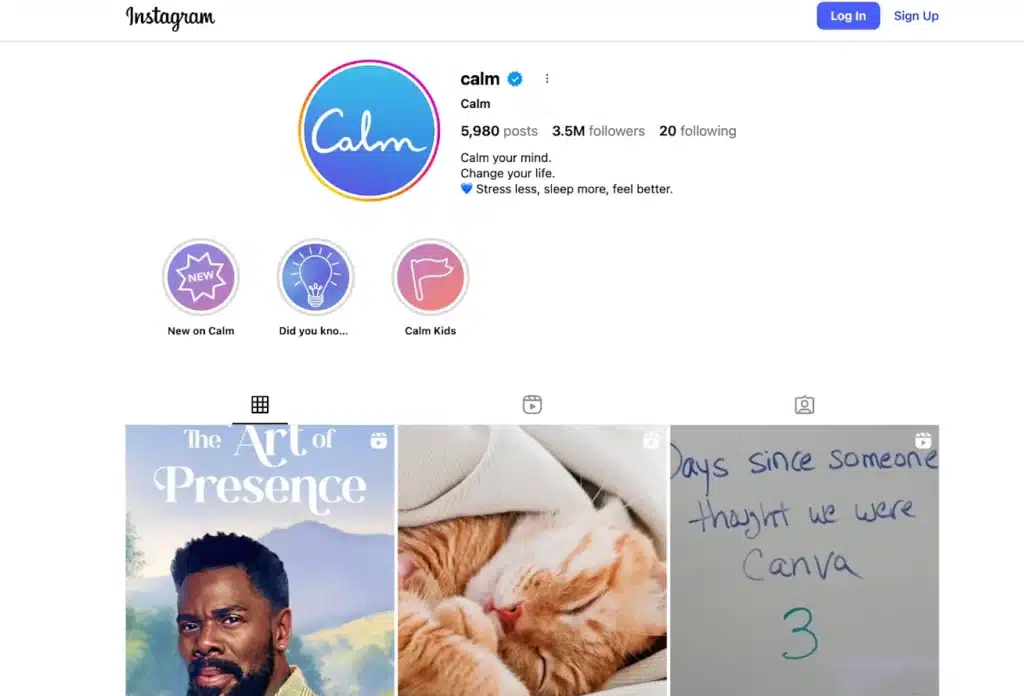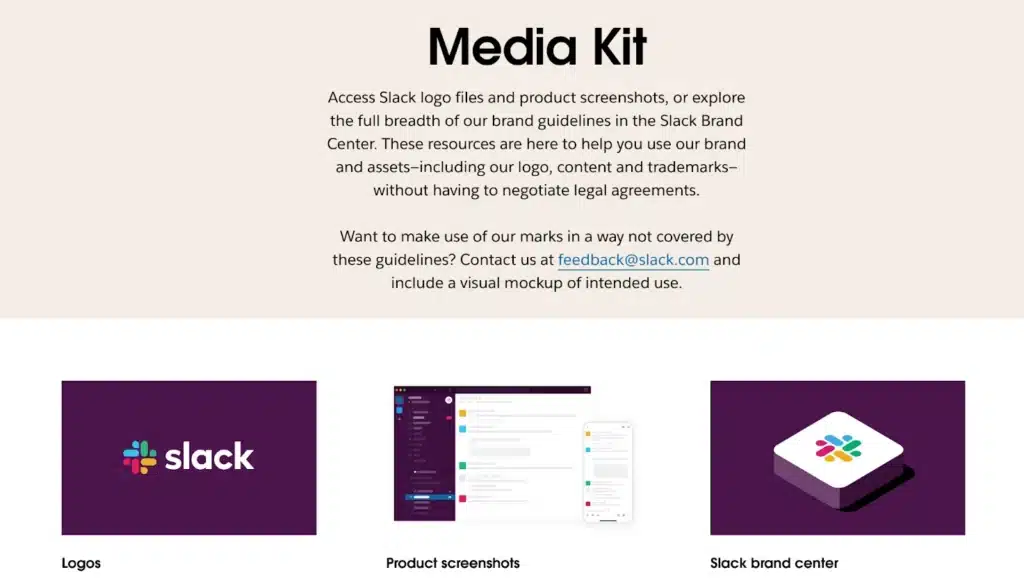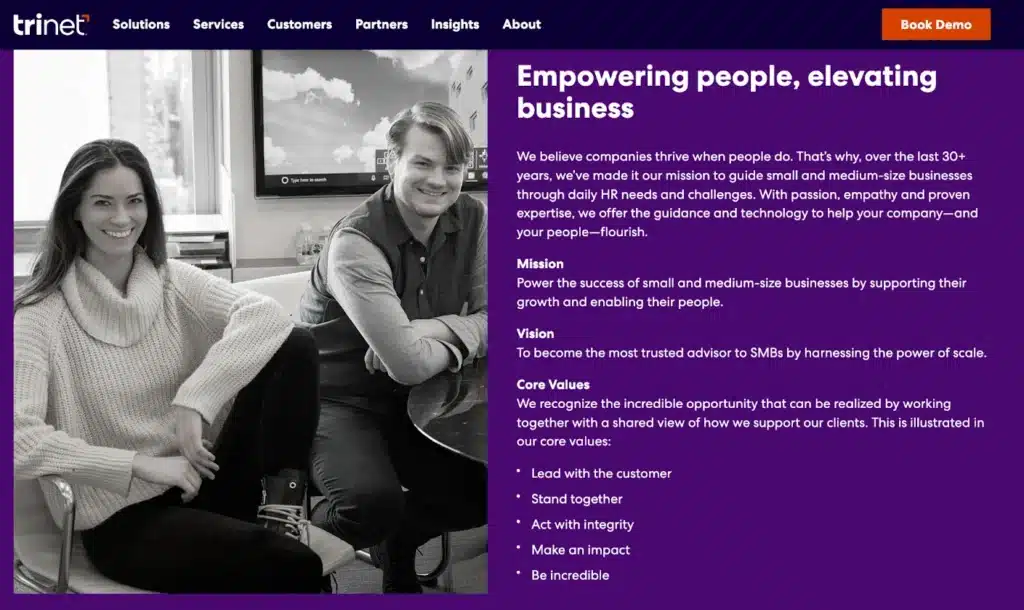What is brand consistency?
Brand consistency means presenting the same identity across all social media platforms and marketing channels, every time. It’s how you build trust, stay recognizable, and reinforce what your brand stands for.
Below are the key elements of maintaining a consistent brand identity:
- Voice: This is how your brand sounds online. Are you friendly and casual? Professional and direct? Sarcastic? Sincere? Your brand voice should stay consistent across every caption, reply, and message to reflect your core brand message and ensure your audience always knows it’s you.
- Values: Your brand values shape your communication style. They influence what you talk about, how you respond to trends, and the types of social media posts you create. If you’re committed to sustainability, inclusivity, or innovation, your content should show it clearly and consistently.
- Visuals: This includes your color palette, font choices, image styling, brand logo usage, and overall design direction, including your video aesthetic. Every piece of content should visually align with your brand assets and feel like a natural extension of your visual identity. Even without your name on it, your audience should still recognize your content.
- Timing: Posting consistently builds brand recognition and trust. Whether you share updates daily, weekly, or monthly, consistency in timing helps your target audience know when to expect fresh content. A regular rhythm reinforces a strong brand presence.
- Audience interaction style: How you engage is part of your brand personality. Do you use emojis? Are your replies playful, professional, or warm? Whether it’s responding to comments or DMs, your tone of voice should reflect a brand consistent experience, not just in what you post, but how you communicate.
Take Calm, for example. Their entire brand experience is, well… calm. Whether you’re scrolling through their Instagram, watching a YouTube ad, or opening their app, you’re met with the same tone of voice: gentle, reassuring, and grounded.

Image source
The visuals are just as aligned: muted colors, minimal design, and nature-inspired imagery. This kind of visual consistency and brand voice helps them build a deep emotional connection with their target audience.
Why brand consistency is non-negotiable on social media
When your audience scrolls through their feeds, they’re bombarded with content. Brand consistency is what helps you stand out and stay memorable across all social media platforms.
If your posts look, sound, or feel different each time across different marketing channels , your brand identity weakens. People won’t recognize you, and worse, they won’t trust you.
We’ve already seen how brand authenticity supports brand recognition, but did you know that staying consistent can also improve your revenue?
One study found that consistent branding can increase revenue by up to 23%. Why is that? Because when customers know what to expect from you, they’re more likely to engage, buy, and come back.
The cost of lacking a consistent brand experience
Inconsistency on social media costs you trust, attention, and growth.
If your tone changes from serious to sarcastic, or your visuals look different every week, your audience won’t know what to expect. That leads to confusion, which in turn leads to disengagement.
According to Forbes, consistency signals that your products and / or services are of high quality. This also makes it easier for people to remember you and choose your brand when making a purchase.
Followers stop interacting when they can’t tell who you are or what you stand for. They scroll past your posts, unfollow your account, or worse, stop trusting your brand altogether.
You can also lose momentum. The algorithms behind social media platforms reward consistent engagement. If your content isn’t getting much engagement, your reach can drop.
The risks of outsourcing social media for branding efforts
Outsourcing social media can save time and boost output, but without a clear brand strategy in place, it can do more harm than good.
For example, if your company offers tools like a softphone or WiFi calling, your social media must clearly convey the benefits these tools provide. Without a strategy, posts may misrepresent your brand or fail to meet your audience’s needs.
Here are some of the risks you can take when you outsource your branding efforts:
- Misaligned tone and messaging
- Visual inconsistencies across platforms
1. Misaligned tone and messaging
Tone is how your brand speaks. Messaging is what your brand says.
If either of these drifts away from your established brand personality, it creates a disconnect, and that disconnect can erode trust with your target audience.
Outsourced teams don’t live and breathe your brand. You do. If they don’t have a documented brand style guide or a clear tone of voice, they’ll default to whatever works for other clients, not necessarily what works for you.
A tone that’s too stiff, too salesy, or too casual can make your brand voice feel inconsistent. Likewise, mismatched messaging can promote the wrong offers, spotlight irrelevant topics, or send a signal that conflicts with your values.
Let’s say your core brand message is focused on being calm and informative. But suddenly, your content says, “This offer slaps 🔥.” Or you’re known for innovation, but your content starts pushing generic “productivity hacks.”
Now you’re left with messaging and tone that don’t belong to you and a broken connection with your audience.
2. Visual inconsistencies across platforms
Your brand should maintain a consistent look and feel no matter the platform. Or, at the very least, have the same core visual elements.
If you outsource without providing a brand style guide or access to your brand assets, your social visuals can quickly go off-brand. That means breaking your visual identity, confusing your audience, and weakening your brand recognition.
Here are a few examples of visual inconsistencies in brand elements:
- Using a bright red background on a post when your brand colors are muted neutrals
- Uploading a pixelated or distorted version of your company’s logo
- Posting stock photos that don’t reflect your audience or brand aesthetic
- Designing Instagram stories with off-brand fonts or inconsistent formatting
- Sharing LinkedIn graphics in one style and Facebook posts in another, with no cohesive link between them
How to maintain brand consistency when outsourcing
You might think that outsourcing your social media means giving up control of your brand. But that’s not the case. Instead, you’re creating systems that keep your voice, visuals, and values front and center. Let’s look at how to do it right.
Here are some actionable steps for maintaining a consistent brand identity; even when outsourcing:
- Create a clear brand style guide
- Share a centralized content library
- Define your audience and brand values
- Use a content approval process
- Choose the right social media partner
- Use tools for project and social media management
1. Create a clear brand guidelines
How do you make sure your brand shows up the same way, every time… even when someone else is handling the content?
You create a brand style guide. It helps keep everything aligned: your voice, your visuals, your message, across social media platforms, campaigns, and collaborators. Whether you’re scaling content or kicking off a new marketing campaign, this one document keeps your brand identity intact and helps you maintain trust.
Here’s what it should include in your brand guidelines:
- Voice and tone: How do you sound? Friendly, bold, casual, direct? Include examples of what sounds right (and what doesn’t) to help others stay on brand when writing captions, comments, or ads.
- Language and emoji rules: Set boundaries for contractions, slang, emojis, and abbreviations. This helps avoid messaging that feels out of character or off-brand.
- Visual elements: Think color palette, logo usage, fonts, imagery, all the pieces that make up your visual identity. These should stay consistent across every post, platform, and asset to help build recognition and trust.
- Formatting preferences: Define what your content typically looks like. Should headlines use title case? Do you like bullet points or longer blocks of text? Details like this support a consistent voice and help people follow your writing style.
- Platform notes: Outline how your tone or design might shift slightly on different platforms, but make it clear that the core brand message stays the same. That’s how you create brand consistency without losing flexibility.
- Posting rhythm: Set expectations for timing and frequency. Whether it’s three times a week or once a day, a steady cadence builds brand recall and keeps your audience engaged.
- Do’s and don’ts: What’s off-limits? Maybe it’s stock photos, overused memes, or topics that don’t align with your company’s mission. Be specific so your team knows where the line is.
Slack nails this. Their guidelines cover everything (tone, design, usage, visuals) and they’re easy for partners to follow. The result is a consistent brand identity across every channel, which boosts brand recognition, customer loyalty, and visibility.


Image source
If your marketing materials, social media posts, or even internal slides don’t match up, people notice. That’s why brand consistency matters. It’s how you stay recognizable, build trust, and create a brand image that sticks, no matter where or how someone discovers you.
2. Share a centralized content library
The more context and tools your outsourced team has, the better they’ll reflect your brand. A centralized content library makes it easier for everyone to stay aligned.
Think of it as your brand’s creative control center.
Your content library should include:
- Approved brand assets (logos, fonts, and visual references)
- Templates for posts, stories, and other marketing materials
- Sample posts that show tone, formatting, and visual style
- Evergreen content that can be repurposed across social media platforms
- A campaign archive so new team members can understand your past branding efforts
This kind of library supports more than just day-to-day posting. It helps you establish brand consistency across everything you share, whether it’s a single tweet or an entire marketing campaign. It also strengthens your brand image by making sure visuals, messaging, and tone stay on-brand, no matter who’s creating the content.
Tip: Consider adding a fully designed social media kit to your library. It’ll help outsourced teams maintain a consistent voice, reinforce your core brand message, and deliver a strong brand identity across channels.
3. Define your audience and brand values
Outsourced teams don’t just need to know what your company does, they need to know who you serve, what you stand for, and why it matters.
That starts with understanding your target audience.
When you’re building buyer personas, don’t just cover basic demographics. Dig into their pain points, goals, content habits, and the language they actually use. This kind of clarity helps your team create content that feels personal (and relevant) across all social media platforms.
The more your team knows about your audience, the easier it is to create consistent messaging that feels like it came from the same brand, not five different people with five different tones.
Documenting your brand values and your company’s mission is just as important. But skip the vague stuff. “We care about quality” doesn’t say much. Instead, show what quality means to your brand. What do you prioritize? What do you stand for? How should those values shape your partnerships, messaging, and visuals?
If sustainability is a core part of your brand story, explain how it should guide everything from product positioning to the type of images you use in a new marketing campaign.
And remember: your audience behaves differently across channels. Your LinkedIn audience likely expects a different tone than your Instagram followers, even if it’s the same person. Share those behavioral insights with your team to help maintain a consistent brand voice, no matter where you’re showing up.
Don’t forget to position your brand within the competitive landscape. What makes your brand different? How should your content highlight that, without taking shots at your competitors?
This is how you establish brand consistency while staying true to your values and how you create a strong brand identity that earns trust and builds loyalty over time.
Here’s a great example of this in action:


Image source
TriNet uses simple, direct language to communicate its mission, values, and vision clearly. Their brand message is easy to understand, and even easier to remember.
4. Use a content approval process
When you’re outsourcing content, having a simple approval process is non-negotiable. It protects your brand and helps you stay on top of what’s going live, especially across multiple social media platforms.
Different types of content need different levels of review. A quick meme for Instagram? Light check. A big product announcement? That needs a few more eyes. The key is to set expectations up front so no one’s left guessing.
Turnaround times matter too. Set deadlines that work for your team, and stick to them. Use a collaborative tool to leave comments, approve posts, and avoid the back-and-forth of endless email threads.
You’ll also want a plan for last-minute situations, like trending topics or urgent support updates. Pre-approved messaging for common scenarios goes a long way.
And if you’re keeping an eye on your share of voice in social media, an approval system helps you stay consistent without sounding repetitive.
5. Choose the right social media partner
Not every freelancer or agency will be a good fit and that’s okay. You want someone who gets your niche, understands how brand voice works, and cares about keeping things consistent.
Ask to see their past work. Review their client portfolios to check if they’ve successfully managed different brand voices. Do their projects feel tailored or copy-pasted?
Then dig deeper: What does their onboarding look like? Do they ask about your values, tone, and brand identity or just your content schedule?
Strong partners will have a clear system in place for learning your brand and sticking to it. They’ll ask thoughtful questions, not just about your calendar, but about your audience, your goals, and what makes your brand worth remembering.
6. Use tools for project and social media management
Even with the best team in the world, things fall through the cracks without the right systems. Content gets delayed. Approvals are missed. A great post ends up buried in a spreadsheet somewhere.
That’s why it helps to have a few solid tools in place not just for posting, but for keeping track of what’s going out, who’s working on what, and when everything’s due.
Project management tools, shared content calendars, and approval workflows aren’t just nice-to-haves, they’re what keep your content aligned with your brand voice, tone, and timing across all platforms. You could also consider using virtual office management software to streamline team collaboration and centralized control.










